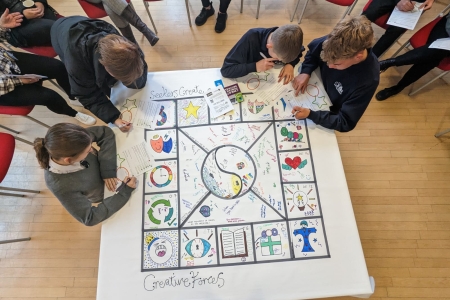

The Widening Participation Outreach team at the University of Portsmouth recently collaborated with Portsmouth-based social creative, Seekers Create, to provide opportunities for the exploration of student voice, as part of our university outreach activity.
The team had been looking for alternative and creative ways to capture participant feedback, and to embed evaluation within our activity rather than it feeling like a boring bolt on survey for the students we’re working with. We’d been tentatively dipping our toes into learning more about how student voice can directly inform future activity and teach us more about the lived experiences of those groups we seek to positively engage in university outreach.
Collaboration
We collaborated with Seekers Create as part of our Creative Forces events; university visit days for young people from Armed Forces families (service children). A little over half of state schools in England have at least 1 service pupil, and in Hampshire there are service pupils in 87% of schools, but they make up only a very small proportion of individual school cohorts (sometimes just 1 pupil). Compared to the general population, proportionally fewer service children progress to university.
Creative Forces events provide a taste of university through a campus visit and subject workshop. They also give the opportunity for service children from different schools to connect with one another, discuss and share their unique lived experiences and to explore the impacts of their experiences on school, peer relationships and education in general.
The brief to Seekers Create was to capture these valuable student insights in a way that was fun, engaging and explorative for the students. And that would help to share the voices of these young people to improve knowledge and understanding among their school staff, their peers and across the education sector, helping other universities to make the case for the inclusion of Access and Participation Plan targets relating to service children. It was important to take a strengths-based approach, exploring the unique skills and experiences of service children and not focussing on possible barriers to progression.
Gamifying student voice
Seekers Create presented the students with a gamified S.W.OT analysis. A scavenger hunt-style trail to follow, answering reflective and explorative questions framed around their Strengths, Wishes, Obstacles and Treasures, and constructed from the outreach team’s broader outcomes framework, which focuses on attitudinal changes towards progression and higher education.
Students worked together as a team to follow the trail and then complete a giant doodle mural, translating their answers into doodles, sketches and scribbles, which they took back to school for display.

Instead of making feel sorry for yourself, it [the game] makes you connect with people as you chat through it.
You understand that I'm not the only one who's experienced these things, many people have and it's just a nice experience to do it with people who understand it.
Year 9 Student, Creative Forces Day Participant
This level of personal reflection led to some really insightful conversations and allowed the team at Seekers Create to facilitate an open question session, recording all the discussion to support with evaluation.
The impact
The honesty, breadth and depth of student insights gathered was profound. The willingness to engage in this form of explorative activity was surprising, and resulted in much richer qualitative data than surveys at previous Creative Forces events and a wealth of audio recordings that will be turned into a supporting resource for anyone who works with service children in an education setting.
Feedback from the participants on the game itself, was that they enjoyed being a part of the process and not just passive participants in someone else’s evaluation of them. We have since engaged a small number of the Creative Forces cohort again, in helping us expand and develop a Creative Forces programme in a process of co-design built directly upon their voices and experiences.
And of course, at an individual level, each school has a wall mural to display and spark conversation in school among friends, teachers, school staff and parents.
My key takeaways for exploring student voice through university outreach:
1. Identify partners for collaboration that share your values
Partners that resonate on a personal level. If they resonate with you, they’ll probably resonate with your audiences too.
2. Loosen your grip on that project brief
Having a clear brief is important, but if you’re collaborating with someone because they’re creative, then let them be creative. When it comes to something as indefinable as student voice, the risk could be worth the reward.
3. Make qualitative data your friend
As outreach practitioners we feel a pressure to prove impact, and it is important, but we inevitably resort to quantifiable statistics to demonstrate the value of our work, because that’s the nature of the environment we’re working in.
But don’t be afraid of engaging in student voice activities because it won’t yield data that can be neatly packaged up using the Likert Scale.
Some of the ways that we’ll be using the qualitative data to share the impact of this project include:
- Podcasts using the voice of service children
- Blogs (including this one!)
- The displaying of doodle murals in the participating schools or their community spaces
- Themes from the student voice data to inform focus groups and co-design groups for future development of service child outreach
- Evidence to inform future Access and Participation Plan targets
- Within professional CPD – check out our Thriving Lives Webinar programme for 2023-24.
Tian Barratt, Outreach Manager at the University of Portsmouth, discusses the value of collaboration in the exploration of student voice within university outreach and how the volume of qualitative insights it can provide can be used to demonstrate the impact of university-led outreach.
